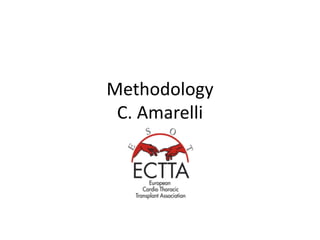European Consensus on Expansion of Thoracic Donor Pool (ECTTA)
- 9. Possible causes of so low extraction of heart donors: ŌĆó PERCEIVED INCREASE OF PGF RATES IN THE LAST DECADE (role of recipient profile) ŌĆó INCREASE OF THE HAZARD FOR PGF WITH THE INCREASE OF DONOR AGE ŌĆó IF LONG ISCHEMIC TIME ARE PROJECTED ŌĆó IF HIGH DOSAGE OF INOTROPES ŌĆó INADEQUATE AVAILABILITY OF DATA (ANGIOGRAPHY, FUNCTIONAL DATA ETC.) ŌĆó PERCEIVED CLINICAL STABILITY OF OUTPATIENT RECIPIENT ŌĆó PERCEIVED AVAILABILITY OF A SURGICAL BACKUP TO TRANSPLANT (MCS) ŌĆó NOT FOR ALL ŌĆó COMPLEX USE FOR BIVENTRICULAR FAILURE
- 17. Landscape and Landmarks Potential Thoracic Organ Donor Early Donor Management Hemodinamic assessment Effective Thoracic Organ Donor Scouting
- 19. Heart Donor Assessment How: ŌĆó RISK FACTORS ŌĆó ECG ŌĆó Ecocardiography ŌĆó Stress Echocardiography ŌĆó ECO TE ŌĆó Angiography ŌĆó Biomarkers ŌĆó Other (CT scan etc.) ŌĆó Multiparametric Scores When ? Who: ŌĆó Local staff ŌĆó Donor Agencies
- 20. Lung Donor Assessment How: ŌĆó RISK FACTORS ŌĆó Radiography ŌĆó Blood Gas Analysis ŌĆó CT Scan ŌĆó Broncoscopy ŌĆó Ecography ŌĆó Microbiology ŌĆó Other (CT scan etc.) ŌĆó Multiparametric Scores When ? Who: ŌĆó Local staff ŌĆó Donor Agencies
- 21. Dynamics changes of Thoracic organs during donation process ŌĆó SYSTEMIC METABOLIC FAILURE BRAIN DEATH OXYGEN DELIVERY OXYGEN CONSUMPTION LACTATE OXYGEN EXTRACTION
- 22. Donor Management How: ŌĆó Swan-Ganz Catheter ŌĆó Other hemodinamic monitoring devices ŌĆó Continuous TEE ŌĆó Bronchoscopy When: ? Role of Early Management Who: ŌĆó Local ICU staff ŌĆó Donor Agencies ŌĆó Scouting Programs
- 23. 1st TOP-Course >ThoracicTransplantation< ŌĆóAdjust volume status: target CVP = 6-10 mmHg ŌĆóCorrect acidosis:target pH = 7.4 ŌĆō 7.45 ŌĆóCorrect hypoxemia: target p02 > 80 mmHg, sat >95% ŌĆóCorrect anemia: target HCT > 30%; Hb > 10 g/dl ŌĆóAdjust inotropics to keep MAP > 60 mmHg (dopamine/dobutamin < 10 ┬Ąg/kg/min) ŌĆóPlace PAC ŌĆóAdjust fluids, inotropes and pressors 15 min to minimize use of alpha agonists and meet targets: ŌĆóMAP > 60 mmHg ŌĆóPCWP 8-12 mmHg ŌĆóC.I. > 2.4 ŌĆóDopamine or dobutamine < 10 ┬Ąg/kg/min ŌĆóCVP 4-12 mmHg ŌĆóSVR 800 ŌĆō 1200 dune/sec/cm-5 ŌĆóT3: 4 ┬Ąg bolus + infusion 3 ┬Ąg/hour ŌĆóVasopressin: 1 unit bolus + infusion at 0.5 ŌĆō 4 units/hour ŌĆómethylprednisolone=: 15 mg/kg bolus ŌĆóInsulin: 1 unit/ hour minimum ŌĆóRule out structural abnormalities Crystal City Consensus circulation 2001
- 24. Inflammatory damage Hyperdynamic storm Endothelial activation ICAM VCAM selectins Neurogenic hypotension Inflammatory cell infiltration Pro-inflammatory cytokines (IL-6, TNF-@, IL-8) TLR - complement Early graft dysfunction Late graft dysfunctin Kidney, Heart, Lung, (Liver) ΔPERFUSION RELEASE FROM BRAIN
- 27. DonorAssessment At Harvesting Time ŌĆó Ischemic Time ŌĆó Age (in absence of coronaric lesions) ŌĆó Inotropic dosage Are risk factors related to the actual gold standard of myocardial preservation: Cold Static Cardioplegic Solutions.
- 30. Donor Preservation How: ŌĆó Cold Static ŌĆó Hypotermic Ex vivo perfusion ŌĆó Normotermic Ex vivo perfusion When: ? Physiopathology of Brain Death Who: ŌĆó Donor Agencies ŌĆó Transplant Centers
- 31. Methods ŌĆó Each of the partecipants to the Core Group should purpose 2 choices for every task so to identify 2 responsibles for every task. ŌĆó Every task should be online on the dropbox open to modifications by everyone (word revision mode) so the responsibles of the tasks can accept or not modification of each of the component of the consensus. ŌĆó Every task may be developed indipendently but bibliographic service may be updated from every partecipants at the best of his knowledge.
- 32. Draft of Tasks and Responsible Role Tasks: ŌĆó Donor Assessment ŌĆó Donor Management ŌĆó Manage Modifiable Risk factors ŌĆó Donor Monitoring ŌĆó Brain Death Pathophysiology and timing for harvesting ŌĆó Scouting Programs ŌĆó Organ Preservation (DBD/DCD) ŌĆó Donor Allocation Protocols ŌĆó Proposal of logistic models to increase the rate of thoracic Organs ŌĆó Specific Considerations about pediatric transplantations Who: ŌĆó Clinicians (cardiologist/pneumologists) ŌĆó Anesthesiologist ŌĆó Anesthesiologist/Surgeon ŌĆó Clinicians/Anesthesiologist ŌĆó Anesthesiologists ŌĆó Cardiologist/Anesthesiologist ŌĆó Surgeons/Anesthesiologist ŌĆó Procurement/Surgeons ŌĆó Procurement Agencies ŌĆó Surgeons
































